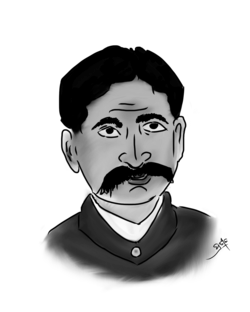Gangadhar Meher
|
Swabhaba Kabi "ସ୍ୱଭାବକବି" Gangadhar Meher |
|
|---|---|

Swabhaba Kabi Gangadhar Meher
|
|
| Native name | ଗଙ୍ଗାଧର ମେହେର |
| Born |
9 August 1862(On the full moon day of Sravan Purnima) Barpali, Bargarh, Odisha, India |
| Died | 4 April 1924 (aged 61) |
| Pen name | Swabhaba Kabi |
| Occupation | Judicial Moharir (Accountant) |
| Language | Odia |
| Nationality | Indian |
| Citizenship | India |
| Education | Std V |
| Genre | Poet |
| Subject | Devotion |
| Notable works | Tapaswini, Rasa-Ratnakara, Balaram-dev, Pranaya Ballari, Kichaka Badha, Indumati (First Published work), Ayodhya Drusya, Padmini (Last work) |
| Spouse | Shanta Devi, Champa Devi (After the death of Shanta Devi) |
| Children | Arjun Meher (died at the age of 12), Bhagaban Meher (Famous as Kabi-Putra), Basumati Meher, Laxmi Meher |
| Website | |
| www |
|
Swabhaba kabi Gangadhar Meher (Odia: ), renowned Odia poet of the 19th century also known as Swabhab Kavi, was a literary Midas, who transformed everything into gold by the alchemic touch of his genius. He was a born poet of delicate charm. His was a clean white style. His poem Bhakti (The Devotion) bears eloquent testimony to the change in religious outlook. He was essentially a poet of intuition and side by side he had a penetrating insight. Though poor in wealth and education, he was very rich in mind and culture. In almost all his writings there is a glimpse of originality.
Gangadhar was born in 1862 on the full moon day of Shravan at Barpali of present-day Bargarh district of Odisha. Chaitanya Meher was working as a village Vaidya (Ayurvedic doctor) besides his family profession of weaving. But as he could not maintain his family with the income of these works, he opened a village school and began to teach a few children. Gangadhar Meher could read up to the Middle Vernacular Standard hurdling over diverse disadvantages, and his excessive desire for reading one day dragged him to the field of writing poems.
As a young boy, he heard the Odia Ramayan composed by Balaram Das and afterwards he himself read it as well as the Odia Mahabharata by Sarala Das. He also read and mastered a great number of Sanskrit books; of which ‘Raghubansam’, deserve mention. He had proficiency in Hindi and Bengali. Tulsi Ramayan in Hindi used to be held by him in great respect. He used to read Bengali magazines and newspapers. Gangadhar, in his student life, read Sanskrit.
Gangadhar got himself married at the age of 10. As his father’s pecuniary condition was not satisfactory, Gangadhar used to go to school in the morning and help his father in weaving in the afternoon. The poet’s weaving was as attractive and beautiful as his poetry. For his clear and beautiful hand writing people used to visit him for writing their documents. The pecuniary condition of the family improved a bit due to his hard labour when to the misfortune of the family, the ancestral house caught fire.
The then Zamindar of Barpali, Lal Nruparaj Singh offered him the post of an Amin (Patwari). Coming to learn of amicable behaviours and good virtues of Gangadhar, the Zamindar promoted him to the post of a Moharir. He continued to serve in the said post and was transferred to Sambalpur, Bijepur and Padmapur and at last transferred to him own native place Barpali on a salary of Rs.30/- P.M.
...
Wikipedia
